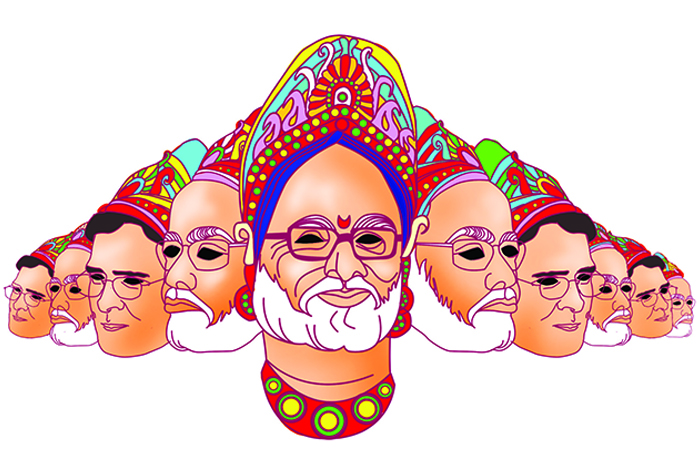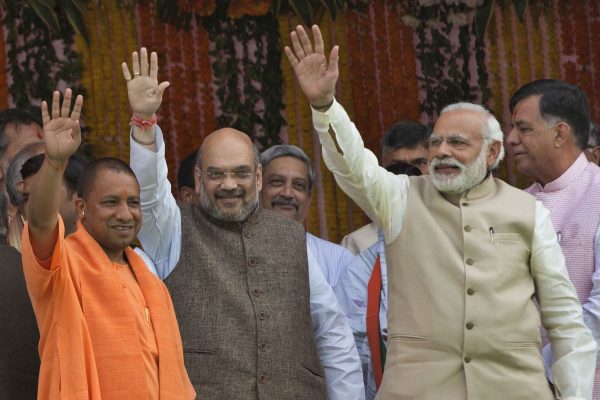Now that the principal opposition party looks set to foist on us a man who presided over one of the worst massacres of Muslims in recent history, all hopes of critically analyzing the ruling coalition’s role in pushing India’s poor further into the abyss of poverty have to be temporarily doused. In the banal logic of reductionism, the political choice now is between corruption and market fundamentalism at one end, corruption, market fundamentalism and communal fascism on the other. Although one is conscious of the political compulsion to choose one over the other, this preoccupation is undoubtedly meaningless for those at the receiving end of Dr Manmohan Singh’s “inclusive development” for the last ten years.
Indeed, the prospect of the formation of a BJP government at the Centre led by Narendra Modi diffuses the absolute criticality of exposing the anti-poor dimensions of policy discourse propelled by the Congress, not to mention the unending scams, corruption and downright inefficiency of the Union Government. Mr Modi does a favour to the Congress in being the biggest issue that will dominate the public discourse in the months to come.
Early this month, I listened to Dr Pronab Sen, the architect of several plans including the soon-to-be implemented 12th Five Year Plan, especially on what he had to say about the excruciating rise in prices of food items. What has happened in India, according to Dr Sen, is that the economy has graduated from a situation of perennial supply-constraint where planners never had to worry about the demand side, to a trend first witnessed in the 10thPlan (1999-2000) that demand constraint was becoming dominant. Among other issues that Dr Sen outlined, the most dominant was that terms of trade shifted from the rich to the poor and that the basic consumption patterns had changed. The cereal consumption, which had already been declining, plummeted further as the consumption of fruit and vegetables increased.
In short, the rise in food items was actually healthy because it showed that the poor in India are now consuming newer and better items. Dr Sen, of course, was not saying anything new. The Prime Minister has been saying for a while now that the price rise is actually a positive sign.
“What prices are going up are prices of vegetables, prices of eggs, prices of fish… that is the secondary and tertiary food items. That is a reflection of the demand for these commodities exceeding supplies,” Dr Singh said at the G20 summit at Cannes in November, 2011. He did not stop at this, adding, “That in turn, to some extent at least, is a sign of growing prosperity of our country. If our national income increases by 8 per cent per annum and our population is increasing at 1.6 per cent per annum, the per capita income is growing at 6-6.5 percent.”
“How cash transfers would work in an economy where infrastructure is wobbly and corrupt is yet another debate.”
That the perversity of such a claim should not be obvious, even to someone as grounded as Dr Singh just proves how right Walter Benjamin was about capitalism being “a form of religion”. Researchers within Dr Singh’s establishment have refuted these claims even if one discounts the monumental tragedy of iniquitous growth and hunger in India mapped so precisely by Prof. Utsa Patnaik in her seminal Republic of Hunger. Sample this for a taste of what actually is happening: “Food inflation in India has been a major challenge to policy makers, more so during recent years when it has averaged 10 per cent during 2008-09 to December 2012. Given that an average household in India still spends almost half of its expenditure on food, and the poor around 60 per cent (NSSO, 2011), and that the poor cannot easily hedge against inflation, high food inflation inflicts a strong ‘hidden tax’ on the poor.” These are observations made in a discussion paper titled Taming Food Inflation in India by Ashok Gulati and Shweta Saini of the Commission for Agricultural Costs and Prices. Of course, Gulati and Saini factor in rising farm wages among other factors in pushing food prices and argue for cash transfers.
How cash transfers would work in an economy where infrastructure is wobbly and corrupt is yet another debate. The dominant paradigm of policy-making for the poor, who are the face of the national campaign launched by the ruling party to showcase the vision of “Bharat Nirman”, has unfortunately been focused on how to “manage” the poor, the dissident and the marginalized as opposed to organically thinking about society as a whole. Pro-poor schemes such as MNREGA, Rajiv Awas Yojna (RAY), the National Rural Health Mission (NRHM), the right-based approach adopted to education as opposed to envisaging and planning for a common school system, the Jawaharlal Nehru National Urban Renewal Mission (JNNURM) have all shown basic flaws which even those helping the government in smoothening rough edges are unable to ignore.
Witness the former National Advisory Council (NAC) member Arun Roy’s angst at the Prime Minister refusing to accept the pre-legislative body’s recommendations regarding something like payment of minimum wages. “I do believe that it is extremely unfortunate the Prime Minister rejected the NAC recommendations on payment of minimum wages to MGNREGA workers and chose instead to appeal the Karnataka High Court judgment ordering the payment of minimum wages to MGNREGA workers. Even more distressing is the Government’s refusal to pay minimum wages even after the Supreme Court refused to stay the Karnataka High Court judgment. It is difficult to understand how a country like India can deny the payment of minimum wages and still makes claims of inclusive growth,” Roy told the Congress president Sonia Gandhi in her May 29 resignation letter.
What it all boils down to is that Keynesian logic— applied from time to time to save Capitalism from its “creative destruction”— is once again failing. The chant of development that the Congress is raising in greater frequency with each passing month is the human face they desperately need to make profit, the face of crony capitalism and monumental corruption acceptable in a country where, according to the UNICEF, malnutrition is more common than even Sub-Saharan Africa; where the government refuses to pay even the minimum wage and the chief planners of the country do not have to fear getting lynched before telling the Supreme Court that Rs 32 a day is sufficient to survive in Indian cities. The more one thinks, the worse it gets. But then, the political alternative that the principal opposition party is presenting is not just worse, it is unthinkable. It is time perhaps to retreat to the Himalayas.


